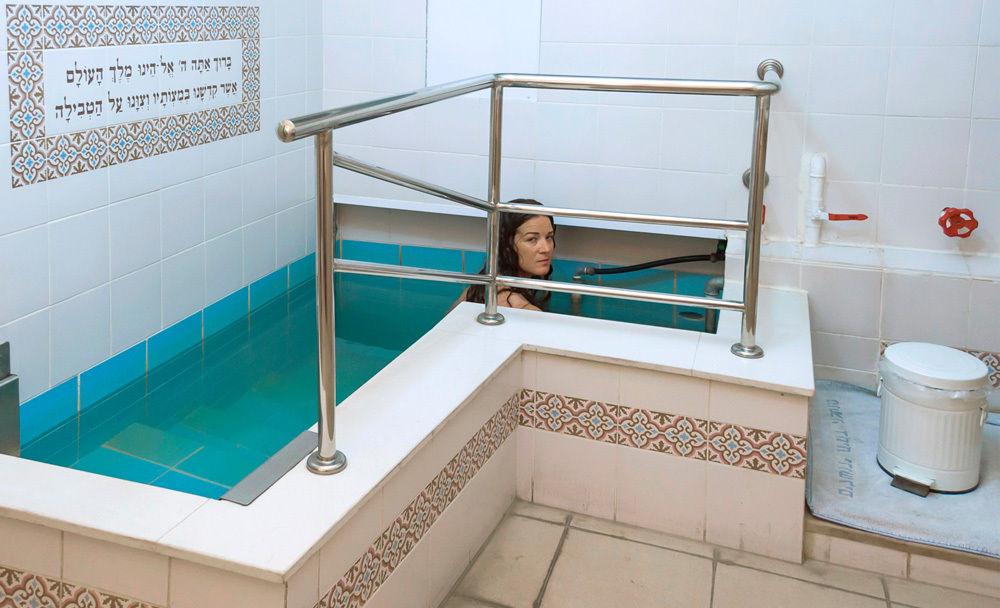Bar Mayer grew up in Israel’s remote ultra-Orthodox community. One of 12 siblings, she’d never watched a film, heard of “art”, or touched a camera. After breaking away from her family and religion at 17 she served in the army and spent eight years abroad working in airport security while trying to come to terms with her identity as an ex-ultra-Orthodox Israeli woman.
In the 15 years since she left home, Bar has used photography to deal with and explore her own and other’s experience living in exile. In her third series on the subject, she’s documenting her subjects’ lingering anxieties. After spending time with each person, Bar designed the portraits to communicate their individual complexes: a woman who left the ultra-Orthodox world after she failed to conceive holds a stone to her belly. Another, marked permanently by her trauma through religion, has the holy text of Ecclesiastes scrawled across her back.
Bar spoke to i-D about her past, and how art and religion aren’t that different.
Before we start, can you tell me a bit about where you grew up?
I grew up in Tifrach, a small village in the south of Israel separated in two: on one side, an Orthodox Jewish community, the other half, secular. There was no communication between them at all—separate schools and grocery stores—they were the “bad part” we were the “good one.”
As a kid, I remember sneaking looks into their windows; that was the first time I ever saw a television, radio, books, and newspapers. They were strictly forbidden inside the community.
I didn’t have much time to do anything as a child that wasn’t related somehow to helping my mom in the household. At school, almost 90 percent of study was religion and some singing, drawing, and sewing classes along with basic english, maths and geography… none of which helped me later when I had to complete my education to enter university.
When did you know you wanted to leave the community?
Since I was about six, my mind was busy questioning. I’d turn lights on during the Sabbath, eat on Yom Kippur, not keep six hours between eating meat and milk—anything that challenged the rules. My mom and older sisters had no time to stop and question anything about how they lived. I just didn’t inherit the adoring of God’s way. Fulfilling my most important feminine meaning—having a husband and many of his babies— was a burden. As I got older it was clear to me if I didn’t leave before they arranged my marriage, I would lose the window for change.
The breaking point came when I secretly went with two other friends to a festival on Valentine’s day. Later I found out I was followed by a group called the mishmeret hazniut or “modesty keepers”. They’re responsible for finding “bad seeds” among the youth. The morning after, at 5AM, when my father had already left the house for prayers, I packed a small backpack and silently left, taking 50 shekels from my mom’s purse. I went to my brother’s in Jerusalem, who had left four years before and who I had been forbidden from contacting.
Did you have any experience of art as a child?
I had never heard the word art in my life. I had some joyful moments in kindergarten and school in drawing lessons, but I had no knowledge of the art world. Later, I found out the art world is more or less structurally built as a religion—it’s another parallel world in which you choose to examine reality, life, and history. This world has strict rules too, some of which I will probably try to break.
I first started photographing at the age of 26. I was living in Germany and fell in love with the ability to form some of my imagination, composing and interpreting reality as I see it. I’d never really had that freedom, especially not as a woman.
Your identity as an ex-Ultra Orthodox Jew is a recurring theme in your work, how has photography helped you navigate that?
Dealing with my identity as an ex-Ultra-Orthodox Jew is a lifetime process. My roots are still there and the gap between us is still widening. All my sisters and brothers have their own families that are growing rapidly—I have 50 nephews.
I look at this gap between the two worlds with the help of the camera. It eases the pain. The camera protects me and allows me to go deeper.
Can you tell me about these portraits, and the relationships that formed between you and your subjects?
This project is my third time dealing with this theme. The first two involved me as the subject. I had to take a step back and detach. The creation of each portrait took between two to three months. Some came more easily, others were tougher. Some of their fears are similar to mine—the process of leaving the community brings up dilemmas and coping mechanisms that have the same DNA.
The portrait of Racheli is the one which I identify with the most. She had to leave the community because she couldn’t get pregnant. If she couldn’t get pregnant, she could never be perfect, not only in the eyes of God, but in the eyes of her close family and community. That is a hell of a burden. I left because I knew either you make babies and fulfil your destiny as a woman in this world, or you are useless.
_Livia Albeck-Ripka is _an Australian freelance journalist and_ fellow at Fabrica Research Centre. Last May, she completed a multimedia research project in Israel on which this piece is based. Follow her on Twitter._
Credits
Text Livia Albeck-Ripka
Photography Bar Mayer
